What Is an Analog Clock?
Analog clock is a tool we use to tell and read time everyday. It is a device that displays the current time using moving hands and a circular dial marked with hours, minutes, and sometimes seconds.
It’s called “analog” because it represents time through continuous, physical motion, as opposed to digital clocks that use numerical displays. Analog clocks are commonly found in homes, offices, schools, and other public places.
There are 12 equal divisions on an analog clock, each division representing 30 degrees.
Here’s an image of analog clock showing 12 divisions, each further divided into 5 equal parts.
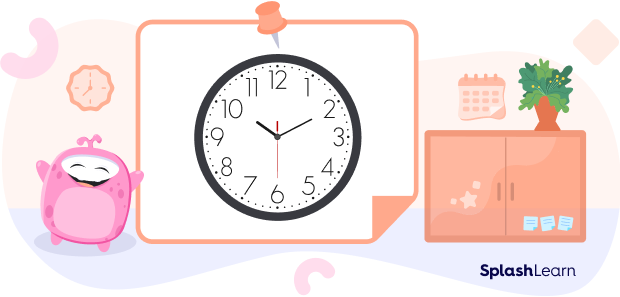
Recommended Games
Definition of Analog Clock
An analog clock is a tool used for reading the time of the day by observing the positions of the clock hands relative to the numbers on the dial.
Recommended Worksheets
Hands of the Analog Clock
Most of the analog clocks have three hands mounted in the center that spin around the clock to tell you the time. These are called clock hands. These hands are used for reading hours, minutes, and seconds.
- Hour Hand on a Clock
The shortest hand is the hour hand. It is usually the biggest hand on a clock with respect to the thickness. The hour hand tells you what hour of the time it is. An hour hand completes a full rotation around the clock dial in 12 hours. Each hour it covers 30 degrees. Every minute it covers 0.5°.
Speed of the hour hand= 0.5° per minute.
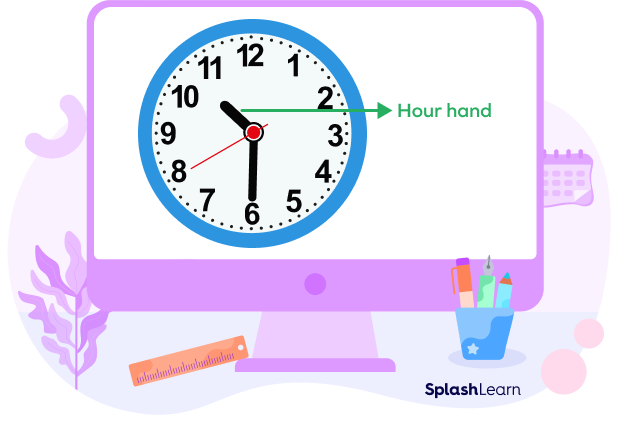
- Minute Hand on a Clock
The longer hand on the clock is called the minute hand. The minute hand completes one full rotation around the clock dial in one hour. Each minute it covers 6°.
Speed of the minute hand = 6° per minute.
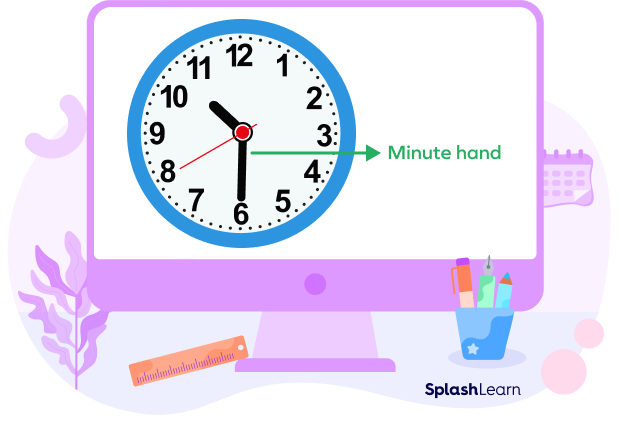
- Second Hand on a Clock
It is the thinnest and the fastest-moving hand. When the second hand makes one full rotation around the dial, it covers 1 minute.
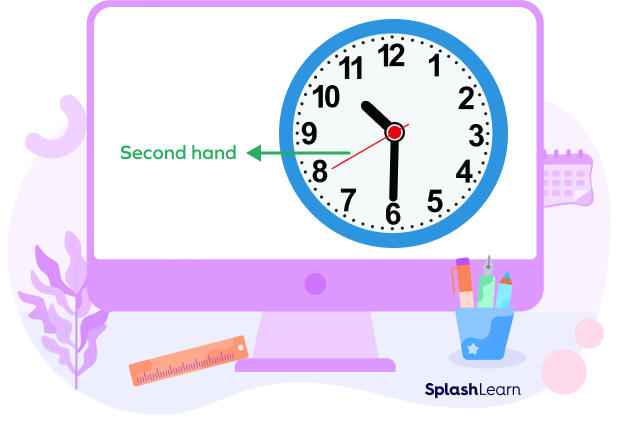
What Is Analog Clock Face?
An analog clock face typically features a circular dial divided into 12 segments, with numbers 1 to 12 or Roman numerals. Two or three hands rotate to indicate hours, minutes, and sometimes seconds, making it a traditional and visual time-telling tool.
- The hands of a clock rotate on the dial or clock face. The dial is marked with the numbers 1 to 12, which are equally spaced. All these positions represent hours.
- Each of these 12 divisions are further divided into 5 small parts, each indicating one minute. Those same marks also indicate seconds for the second hand.
- A clock face with minutes typically features minute markers, such as small lines or numerals, around the circumference of the clock dial. These minute indicators help accurately determine the exact minutes when reading the time on an analog clock, allowing for precise timekeeping.
On some clocks or watches, the Arabic numbers might be replaced with roman numerals, but the process of reading the clock works the same.
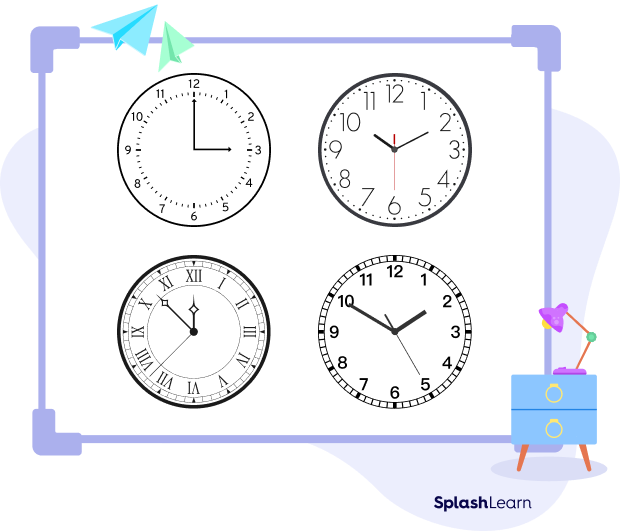
How to Read an Analog Clock
Let’s understand how to read a clock and tell time accurately.
- Read the number of hours: To read an analog clock, first read the hours. Observe the position of the hour hand. When the hour hand is in between two numbers, the number behind the hand is the current hour.
- Read the number of minutes: Next, we read the minutes. Check the position of the minute hand. There are 12 numbers on the clock. Every number represents the corresponding multiple of 5.
If the minute hand, when it points to 1, it indicates 5 minutes past the current hour.
If it points to 2, it reads 2 5 = 10 minutes
Note: When the second hand completes one full rotation around the clock, it indicates 60 seconds or one minute has elapsed. Generally, we don’t usually mention the number of seconds when indicating the time, unless we need to emphasize precision.
Example 1: In the given clock, the hour hand is between 1 and 2. So, it indicates 1 hour.
The minute hand points to the number 6. Thus, it indicates 6 5 = 30 minutes
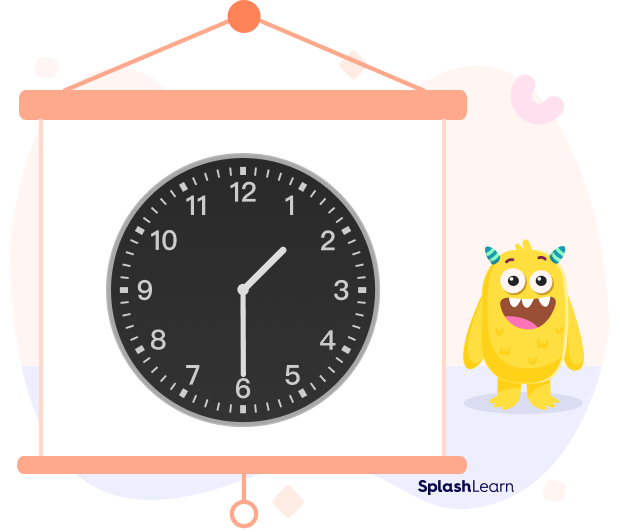
Example 2: When the hour hand aligns with a clock number and the minute hand is on 12, that number indicates the current hour.
What Is Quarter Past, Half Past, and Quarter To?
- Quarter Past:
“Quarter past” is a term used to tell time and means exactly 15 minutes past the hour. When the clock’s minute hand points at the number 3, it indicates that a quarter of an hour, or 15 minutes, has passed since the previous hour. For example, if it’s “quarter past three,” the time is 3:15.
- Half Past:
“Half past” is another time-telling term and signifies 30 minutes past the hour. When the minute hand of the clock points directly at the number 6, it indicates that half of an hour, or 30 minutes, has passed since the previous hour. So, if it’s “half past seven,” the time is 7:30.
- Quarter To:
“Quarter to” is used to describe a time that is 15 minutes before the next hour. When the clock’s minute hand points at the number 9, it suggests that there are 15 minutes remaining until the clock strikes the next hour. For instance, if it’s “quarter to five,” the time is 4:45.
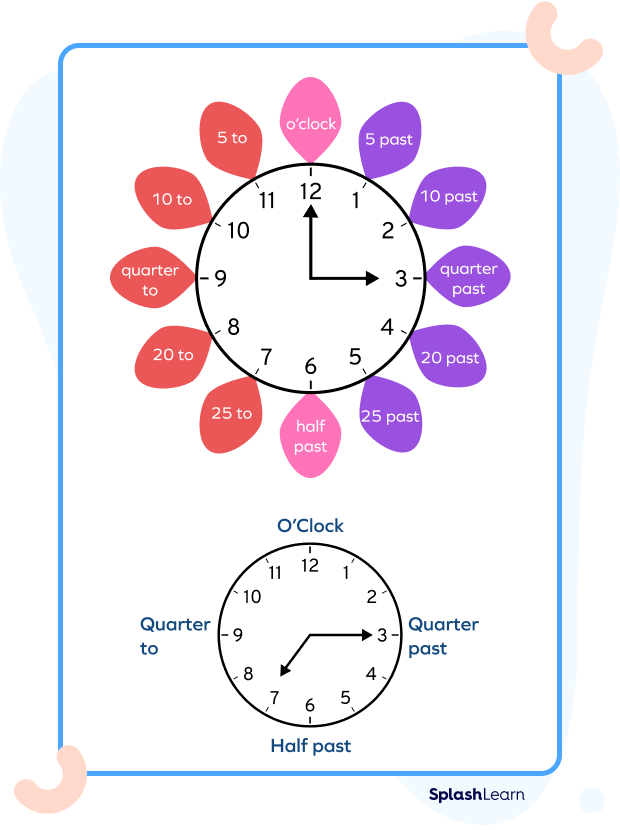
Let’s summarize!
| Quarter Past: | It means 15 minutes past the hour.The minute hand points at 3 on the clock. | 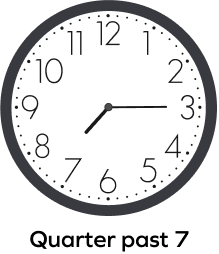 |
| Half Past: | It means 30 minutes past the hour.The minute hand points at 6 on the clock. | 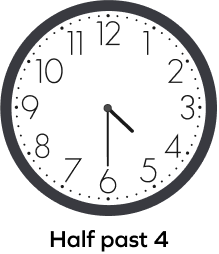 |
| Quarter To: | It means 15 minutes before the next hour.The minute hand points at 9 on the clock. | 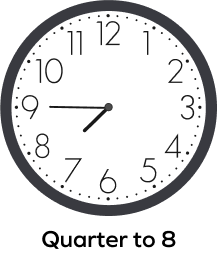 |
How to Read the Analog Clock Time without Marked Numbers
Reading a clock without numbered markings can be challenging at first. However, the process is essentially the same as with numbered clocks. We mentally place the numbers and determine where the clock hands point. With practice, telling time without numbers becomes easier.
How to Set an Analog Clock
To set the time on an analog clock, locate the knob at the back, which controls the movements of clock-hands. When you turn the knob, the minute hand moves first. To set the desired time, rotate the minute hand to match the hour, and then adjust the minute hand accordingly.
Example: To set the clock to 2:15, align the hour hand with the 2 and the minute hand with the 3. Similarly, to set it to 4:00, position the hour hand at 4 and the minute hand at 12.
Analog Clock vs. Digital Clock
We use analog and digital clocks on a daily basis. Let’s compare them using simple points.
| Analog Clock | Digital Clock |
|---|---|
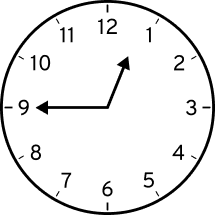 | |
| It uses physical clock hands to show time, and comes with a circular face divided into 12 divisions, each representing 1 hour. | It displays time numerically using digits (numbers) on an electronic screen. |
| It usually has two hands: the hour hand and the minute hand. Some analog clocks also have a second hand. | Does not have physical hands; time is shown using numerical digits. |
| May require periodic adjustments to ensure accuracy as they can run slightly fast or slow. | Generally highly accurate and does not require manual adjustments. |
| It requires some skill to read, especially for young children. | It is simple and straightforward to read, making it accessible for people of all ages. |
| It is very useful for teaching essential concepts like telling time, fractions, division, and more. | Helpful for teaching numerical time representation, but may not be helpful in understanding clock face concepts. |
| Commonly found in homes, schools, and public spaces. | Prevalent in various devices such as smartphones, computers, watches, and appliances. |
12 Hour-Clock and 24 Hour-Clock
- 12-Hour Clock
The 12-hour clock is the most commonly used time format in everyday life. It divides the day into two 12-hour periods: AM (Ante Meridiem) for morning hours and PM (Post Meridiem) for the afternoon and evening. This clock format is known for its simplicity, making it easy for people to understand and use.
Example: 9:00 AM is interpreted as nine o’clock in the morning, while 3:30 PM represents half-past 3 in the afternoon. The 12-hour clock is especially prevalent in casual conversations and non-military contexts and uses “midnight” for 12:00 AM and “noon” for 12:00 PM.
- 24-Hour Clock:
The 24-hour clock is a time convention that follows a continuous time scale without the distinction of AM and PM. It is often referred to as military time or the “European” time format. This clock system counts time from midnight (00:00) to the next midnight (24:00) in a single cycle, emphasizing its continuous nature. It eliminates any ambiguity associated with AM and PM, which can be especially useful in situations requiring precision and clarity.
Example: 14:30 in the 24-hour clock corresponds directly to 2:30 PM in the 12-hour clock. The 24-hour clock is commonly used in aviation, transportation, and scientific contexts.
- How to Convert Between 12-Hour and 24-Hour Time Formats
i) To convert from a 12-hour clock to a 24-hour time, simply keep the AM timings (midnight to noon) the same and add 12 to the PM periods (noon to midnight).
For example, 06:00 AM stays the same as 06:00, but 06:00 PM becomes 18:00.
ii) To convert from a 24-hour clock to a 12-hour time, subtract 12 from the hour if it’s 13:00 or later, and add “PM” to the time.
For example, 16:00 becomes 4:00 PM in a 12-hour format.
| 12-hour clock | 24-hour clock |
|---|---|
| It represents time using a 12-hour cycle with AM (morning) and PM (afternoon/evening). | It uses a 24-hour cycle without AM/PM distinction, from 00:00 to 24:00. |
| Commonly used in everyday life, conversations, and non-military contexts. | Commonly used in aviation, transportation, military contexts, and scientific fields for precision. |
| Used in analog clocks. | Used in watches, mobiles, laptops, computers, etc. |
Facts about Analog Clocks
- Analog clocks use hands to display time. They typically have a circular clock face divided into 12 hours.
- Analog clocks can be either 12-hour or 24-hour format.
- Midnight is represented as 12:00 AM, and noon as 12:00 PM on a 12-hour analog clock.
- The 24-hour analog clock eliminates the AM/PM distinction and counts time from midnight (00:00) to the next midnight (24:00).
- Analog clocks are found in various settings, from homes and offices to public spaces.
Conclusion
In this article, we learned about the fundamental concept of an analog clock, how it signifies time through continuous hand movement, and its distinction from digital time displays. Understanding analog clocks is a valuable skill. To enhance your grasp of the topic, let’s engage in practical examples and MCQs for deeper comprehension.
Solved Examples on Analog Clocks
1. What time is shown by the clock?
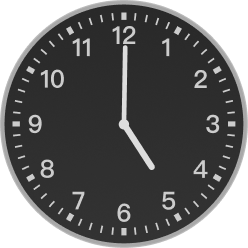
Solution:
The hour hand points to 5.
So, current hour = 5
The minute hand points exactly to 12.
Therefore, the time is 5 o’clock.
2. What time is shown by the clock?
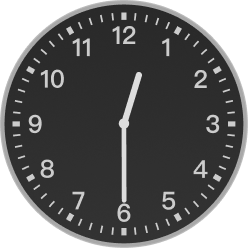
Solution:
The hour hand points in between 12 and 1.
It reads 12 hours.
The minute hand points to 6.
6 5 = 30 minutes.
The minute hand represents 30 minutes.
The time is 12 hours 30 minutes or 12:30.
3. Anna reads the time on a clock as 13:00 using the 24-hour format. What is the time in the 12-hour clock format?
Solution:
To convert from a 24-hour clock to a 12-hour time, we
i) subtract 12 from the hour if it’s 13:00 or later
13 – 12 = 1
ii) add “PM” to the time.
Thus, the time is 01:00 PM.
4. What time is shown by the given analog clock?
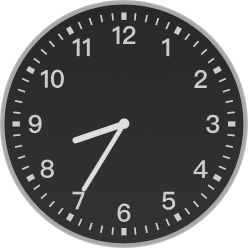
Solution:
The hour hand is between 8 and 9. It represents 8 complete hours.
The minute hand points exactly to 7.
7 5 = 35 minutes.
Minute hand represents 35 minutes.
The analog clock reads 8 hours 35 minutes or 08:35.
5. What does 10 past 5 mean?
Solution:
10 past 5 means 10 minutes after 5 o’clock.
Thus, 10 past 5 = 05:10.
Practice Problems on Analog Clocks
Analog Clock – Definition, Clock Face, Clock Hands, Examples, Facts
What time is shown by the clock?
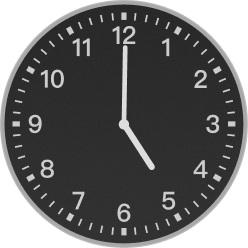
The hour hand is exactly at 7.
The minute hand is exactly at 12.
Thus, the clock reads 07:00.
Read the time represented by the given analog clock.
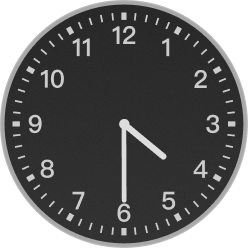
The clock reads 04:30.
In other words, it reads “half past 4.”
The shortest hand on the clock is the_________ .
The shortest and thickest hand is the hour hand.
What time does the given analog clock show?
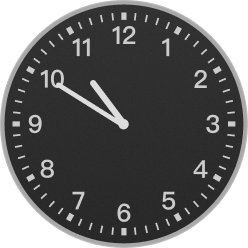
The hour hand is between 10 and 11.
So, it has covered 10 hours.
The minute hand points directly at 10.
Thus, it represents $10 \times 5 = 50$ minutes
Thus, the clock reads 10:50.
Quarter to 9 =
Quarter to 9 means “15 minutes before 9 o’clock.”
Thus, it represents the time 08:45.
Frequently Asked Questions about Analog Clocks
What does analog mean?
An analog clock is a clock with hands. In the context of an analog clock, “analog” signifies the method of displaying time through hands on a dial rather than using numerical digits. As the clock hands move continuously along their circular paths, they represent an unending sequence of real numbers, marking the ongoing moments of time. This continuous motion gives the clock its name, “analog clock.”
What does o’clock stand for?
The term “o’clock” is a contraction of the phrase “of the clock.” When you say “o’clock” after a specific hour, it indicates that it is exactly that hour with no additional minutes. For example, “2 o’clock” means it is exactly 2:00. The term is commonly used in telling time to specify the exact hour when there are no minutes to report.
How do you convert from a 12-hour clock to a 24-hour clock?
To convert from a 12-hour clock to a 24-hour clock, simply keep the hours the same for AM times (midnight to noon) and add 12 to the hours for PM times (noon to midnight).
Example:
6 AM = 06:00
5 PM = 17:00 because 5 + 12 = 17.
Which hand is the hour hand on an analog clock?
The shortest and thickest hand on a clock is typically the hour hand.




































